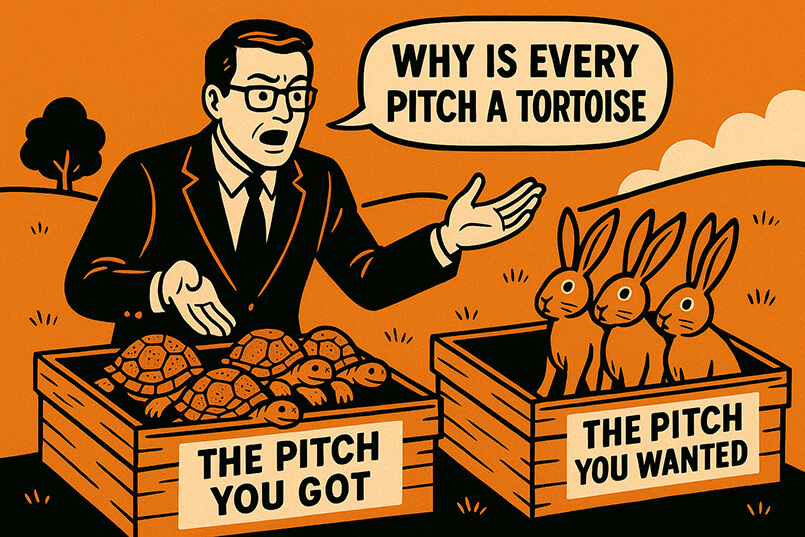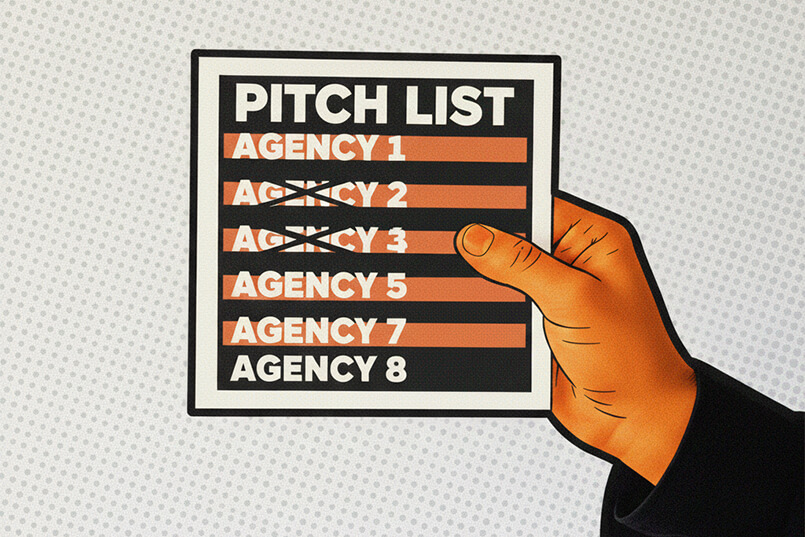In the business world, there is a lot to be said for working quickly, using a fast process to reach a timely and well-informed decision.
Fast decision-making is important for many reasons, including minimising waste in terms of time, resources, and cost, better allocation of resources, and better productivity for the business team. It keeps the business moving ahead of the competition and avoids the risk of team frustration and burnout that comes with extended processes.
What’s true of the business world in general tends to be doubly true in the marketing department. Marketing teams are set up to act quickly, respond to changing market conditions promptly and generally be ready to outpace the competition. The intense pressure to move fast is often passed on, with double the emphasis, to agencies. And yet – when it comes to pitching for a new agency, so much of this good practice seems to go out of the window. Why?
Let’s step back for a moment and examine the reasons and see how we can make things move faster in the world of pitching.
The common problems that lead to slow pitches
Problems arise at the project’s inception. The starting point for most pitches is one of three requirements: firstly, the procurement-driven, end-of-contract re-pitch; secondly, performance shortfalls from the existing agency; and thirdly (and least commonly), a new business initiative requiring a brand-new agency solution.
In each case, circumstances tend to slow things down. Procurement-driven pitches are often seen as unpopular or, at best, low priority for the marketing team. Procurement professionals are naturally focused on being thorough rather than quick, so the pitch moves at their pace rather than the faster rhythm of a marketing team.
In contrast, the pitch driven by a failing relationship is mainly a marketing necessity, and the team needs a quick resolution. Unfortunately, this can result in haste rather than genuine speed – ‘just do it’ instructions often cause false starts, flawed processes that lead to poor or delayed decisions, and the need to do extra work as mistakes are corrected during the process.
A shift in strategic business direction or a new market initiative usually moves at a slower pace to allow for thorough planning and risk assessment, which will naturally affect the agency pitch on the timing schedule.
Finally, the marketing team doesn’t have enough time to manage and fully take part in an agency tender or pitch, since they already have a full-time marketing role. This causes timing conflicts and delays as marketing staff and other internal stakeholders juggle their commitments and schedules to accommodate the pitch process.
All of this is entirely understandable – we are all human. But a slow pitch can have multiple negative impacts.
Problems with slow pitching
There are many; here is an illustrative selection of some that we have come across over the years:
Higher costs – longer pitches consume more client time and resources. This translates directly to cost, which might not be directly logged but will have an impact through lack of time for other projects and BAU tasks. And this is equally true of agency man-hours, which are much more closely monitored by the management team. An agency hour invested in a pitch is a billable hour lost.
Outdated briefing – if a pitch continues over too lengthy a period, market conditions will move on, consumer trends can change, and there can even be changes to the client team with a significant impact on decision-making. Any of these circumstances has the potential to require the whole process to fail or to start again.
Agency fatigue – Agencies have other clients to look after. They are usually keen to put their best talent on a pitch, but that talent does not sit around waiting for a pitch to appear – it has to earn its keep through paid-for client work, which will sooner or later take precedence. A protracted pitch can exhaust the initial enthusiasm and might even lead to withdrawal from the process.
A lower standard of work – a slow process can result in a lack of faith in the robustness of the process, which will distract the agency team from their focus. At its worst, this can result in reduced standards. But even if this can be avoided, does more time automatically mean better work? Most agencies are set up to work fast under pressure. A recent candid conversation I had with a high-profile agency CEO crystallised this: “Give us three weeks and we should be able to come up with our best work. Give us three months and we will probably get to the same solution, but with more charts.” Who needs this?
Positive steps to a faster pitch process
The need for speed is clear; the route to achieving it lies primarily in the process that drives the pitch and how this facilitates good decision-making.
Let’s be very clear about something here – it is important not to confuse ‘quick’ with ‘hasty’. Quick decisions are efficient, well-informed by meaningful data, and definitive. They involve making the best possible choice within a reasonable timeframe. Hasty decisions are often impulsive and poorly researched, usually leading to avoidable mistakes, and are much more reversible.
A thorough pitch process, such as TrinityP3’s BetterPitch, will optimise the decision-making process, removing bottlenecks and avoiding any hint of ‘analysis paralysis’. At the set-up, we will always look to establish a clear roadmap: defining who has the power to make specific decisions and what is needed to make them. This will include good information flow to ensure relevant data is efficiently created and supplied, as well as a clearly defined and agreed-upon timeline covering the entire pitch. The timeline should be set up to allow for team availability, with dates for all decisions agreed upon upfront – from the initial long list to the negotiated appointment.
It is absolutely vital that the whole team commits to the timetable and sticks to it. Just as important is that the timetable and process is made transparent to the agencies so they can be confident in the integrity of the pitch.
Fast pitching is BetterPitching
‘Fast’ doesn’t imply any lack of flexibility – a more complex brief (for instance, across multiple markets or covering multiple objectives) will probably need more time for the agencies to respond comprehensively to the brief, but still within the rules already described.
A fast pitch will maintain focus and ensure that the enthusiasm generated at the start of the pitch is maintained to the end. BetterPitch is laser-focused on this, with tailored and streamlined processes designed to eliminate waste and maintain high energy levels. A fast pitch will contribute to everyone involved being able to enjoy the process more, and Fun is one of our five guiding principles for BetterPitch. Fast is another, along with Fit, Focused and Fair. All are closely interrelated.
We promise to bring them to every pitch we run, to achieve a better result for everyone involved.
You can read more about the BetterPitch process here or contact us for a confidential discussion about how to pitch better.




